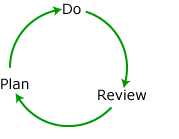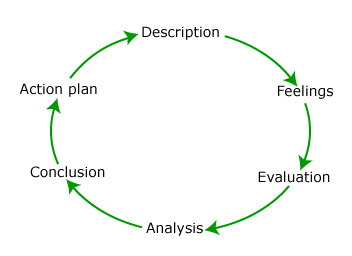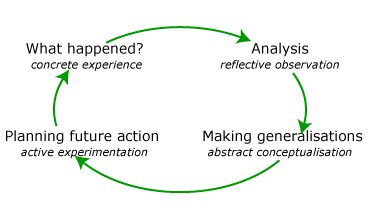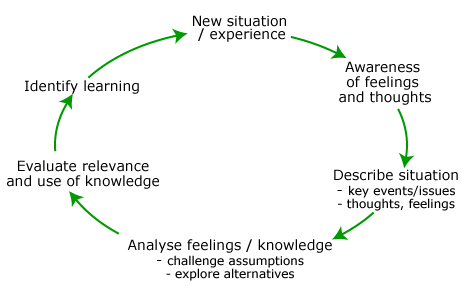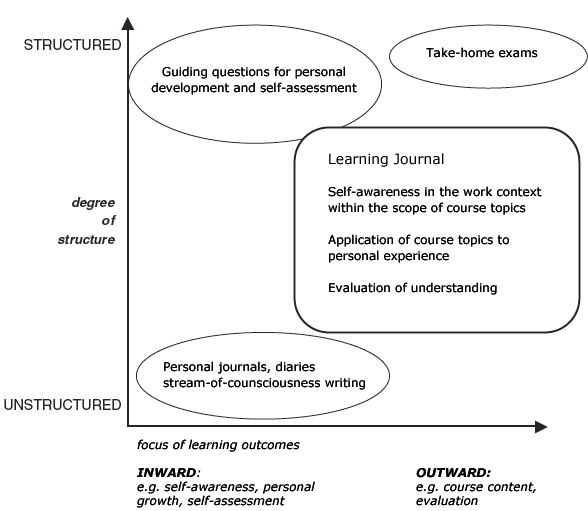Reflection: Difference between revisions
m (using an external editor) |
|||
| Line 100: | Line 100: | ||
The three levels are examined from the perpectives of the reflective practitioner (student), other stakeholders (client) and the particular context to discern the role each plays in the course of current and future events. | The three levels are examined from the perpectives of the reflective practitioner (student), other stakeholders (client) and the particular context to discern the role each plays in the course of current and future events. | ||
[[media:Tornado.jpg|Table of Rubric for assessment of | [[media:Tornado.jpg|Table of Rubric for assessment of reflection in service learning journals]] from Marchel (2004). | ||
In Marchel's rubric, the percentage of journal content pertaining to each level is tabulated over the course of multiple journal entries. The desired progression, indicative of an improvement in reflective capacities, is a move to greater portion of the reflective writing focusing on Level III-type reflections. | In Marchel's rubric, the percentage of journal content pertaining to each level is tabulated over the course of multiple journal entries. The desired progression, indicative of an improvement in reflective capacities, is a move to greater portion of the reflective writing focusing on Level III-type reflections. | ||
==The role of technologies in reflection== | ==The role of technologies in reflection== | ||
Revision as of 18:34, 14 April 2008
<pageby comments="false"/>
Definition
Reflection is a metacognitive strategy to help learners as individuals or organizations reflect upon experiences, actions and decisions taken. A practitioner engages in reflection when problem in practice arises and an attempt is made to understand and resolve it. Reflection as a pedagogy can be seen as an application of Dewey's experiential learning theories and extension to problem-based learning based on constructivist values. Reflection involves an active exploration of experiences to gain new or greater understanding.
History
Reflective thought as a learning process was first given importance and described by Dewey in How We Think (1933) as an 'active, persistent, and careful consideration of any belief or supposed form of knowledge in the light of the grounds that support it and the further conclusions to which it tends' (Dewey 1933: 118 in Smith 1999). He described 5 types of thought related to reflection that could be interpreted as a process.
Upon experience:
- leap to possible solutions
- intellectualization of problematic experience into problem to be solved
- use of hypotheses to guide further observation and information gathering
- elaboration of ideas in to a reasoned supposition
- experimentation and testing of hypotheses
Models of reflection
Reflection is presented as a cyclical stage process and many stage process models of reflection have been proposed to be used as metacognitive tools. The models all share some variation of three basic stages: experience (the event and feelings toward it), a critical analysis of the situation and any new knowledge gained, development of and internalization of new perspectives and strategies to apply in the future.
Schön's model of reflective practice
Donald Schön looked at differentiating the tacit knowledge inherent in expert practitioners from explicit technical or theoretical knowledge, defining the notions of reflection-in-action (the use of a repertoire of theories, examples and actions to new situations, i.e. the capacity to think what one is doing while doing it) reflection-on-action (looking at the event or problem and how it was dealt with afterwards) (Schön, 1983).
The practice of using reflection as a learning strategy appears to focus on turning the latter into the former, so that learners may better capitalize on the learning opportunities offered in a particular experience and internalize the knowledge gained through their experience in order to build up a repertoire to draw upon in the future.
Other models
Greenaway 3-stage model
Based on a simple 3-stage experiential learning cycle the Greenaway model suggests a Plan>>Do>>Review>> cycle
Gibbs’ reflective cycle (1988)
Johns’ model for structured reflection (1994)
More of a list of key questions to guide an analysis of a incident or general experience. Johns recognizes the benefits of sharing reflections which is an essential part of building a community of practice and the importance of the 'situatedness' of an incident as highlighted by the attention given to influencing factors and learning as involving considering actions to support others.
- Description: Drawing out of the key issues within an experience through a description of thoughts and feelings and contextual background of the experience
- Reflection: Examination of one's motivations and the resulting actions, the consequences of actions for all stakeholders (including their possible emotional reactions).
- Influencing factors: Determining internal and external factors that influenced decisions and actions.Determine knowledge that did or should have influenced decisions and actions.
- Alternative strategies: Evaluation of one's actions and consideration of other possible choices and their respective consequences.
- Learning: Situating the experience and feelings within past experience and future practice and in providing support to others and considering the impact the experience will have on reflection-in-action.
Structured reflection based on Kolb’s Learning Cycle (1984)
A model based directly on Kolb's experiential learning cycle where active experimentation leads to a transfer of learning from current cycle to a new cycle.
based on model described at [1]
Rolfe et al (2001) Framework for reflexive practice
What? >> So what? >> Now what?
Atkins and Murphy’s stage model of reflection (1994)
adapted from Atkins S, Murphy K (1994) found at [2]
Use of reflection in education
Promoting reflection-on-action
Any and any combination of these have been suggested as ways to enhance reflection-on-action (Sherwood, 2005; )
- Reflective writing in journals or blogs
- Video and Audio taping
- Critical incident technique - identifying particular helpful or unhelpful behaviours in a specific critical situation
- Discussion
- Drawing/ Concept mapping
- Role playing
- Storytelling
Promoting reflection-in-action
According to KBenetos, here the methods become a little more esoteric, but the aim of these activities are to provide physical relaxation and mental awareness and grounding that will enhance reflection in a particular situation.
- Mindfulness
- Meditation/Yoga/Physical activity
- Music
Reflective writing
Writing assignments that require students to engage in critical and reflective thinking can be used in a variety of learning situations and across many disciplines. Reflective writing can include the use of readings, observation and experience related to the learning situation in question. Reflective writing assignments can be highly structured as in a take-home exam or unstructured as in stream-of-consciousness writing. Reflective writing may also be inwardly or outwardly focused depending on the degree to which reflection is directed towards self-awareness or development of domain content (Varner & Peck, 2003).
Types of reflective writing assisgmnents taken from Varner & Peck (2003, p. 4)
Assessing reflective writing
Marchel (2004) suggests a rubric to evaluate reflective writing. The rubric evaluates three levels of reflection and awareness:
- Level I: Descriptive - description of the situation and the reactions of all involved
- Level II: Analytical - analysis of context and consideration of the other and their interrelations
- Level III: Integrated - discussion of one's feelings and reactions and their impact in the particular and possible broader contexts with a focus on future actions
The three levels are examined from the perpectives of the reflective practitioner (student), other stakeholders (client) and the particular context to discern the role each plays in the course of current and future events.
Table of Rubric for assessment of reflection in service learning journals from Marchel (2004).
In Marchel's rubric, the percentage of journal content pertaining to each level is tabulated over the course of multiple journal entries. The desired progression, indicative of an improvement in reflective capacities, is a move to greater portion of the reflective writing focusing on Level III-type reflections.
The role of technologies in reflection
A variety of ICT-based tools can be used in reflective practice:
- Online journals or blogs for reflective writing
- Social software such as CSCL, CSCW, Chats and Wikis for synchronous and asynchronous discussions and sharing of stories and experiences
- Microworlds and MOOs for role-playing
Related articles
Metacognition, Writing-to-learn, Situated learning, Experiential learning
Related links
- Using a model of reflection
- Experiential Learning Cycle.
- Reflection
- The Reflective Practitioner - some definitions of reflective practice
- Blogs as reflective practice - presented at the Online Educa Berlin eLearning conference in 2006
References
- Atkins S, Murphy K (1994) Reflective Practice. Nursing Standard 8(39)49-56.
- Dewey, J. (1933) How We Think, New York: D. C. Heath. Classic and highly influential discussion of thinking. in Smith, M.K. (1999). Reflection. article in the Encyclopaedia of Informal Education. [3]
- Facilitating reflective practice.Peer Review of Learning and Teaching page at Cardiff University. Cardiff University 2007
- Greenaway, R. (1988). Powerful Learning Experiences in Management Learning and Development [4]
- Marchel, Carol A. (2004). Evaluating Reflection and Sociocultural Awareness in Service Learning Classes, Teaching of Psychology, 31 (2) 120-123 .
- Schön D (1983) The reflective practitioner. Basic Books: New York
- Sherwood, G. et al. (2005). The Scholarship of Reflective Practice, a resource paper from the Scholarship of Reflective Practice Task Force at University of North Carolina at Chapel Hill School of Nursing. [5]
- Varner, D., Peck, S. (2003). Learning From Learning Journals: The Benefits And Challenges Of Using Learning Journal. Journal of Management Education [6] (Access restricted)
